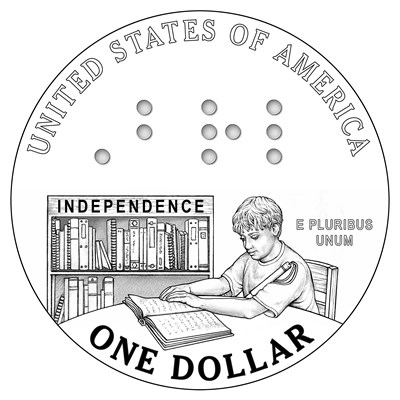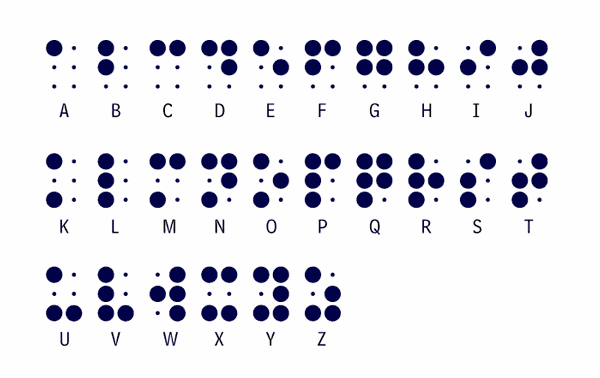 |
| Louis Braille Silver Dollar in celebration for Br (http://www.thecoincottage.com/images/usmint/2009LouisBrailleReva.jpg) |
Louis Braille, (born in Coupvray, France in 1809) the fourth child of Simon-René Braille and Monique Baron, “opened the doors of knowledge” (monument to Braille in Braille Square) to the blind by inventing a system that allowed them to read and write simply and easily. At three years of age, Braille had a tragic accident in which he stabbed himself in his eye with an awl. By five years of age, Louis Braille became completely blind by way of spread infection.
The town Father, Father Palluy, taught Braille three days a week. After a while Palluy came to realize that Louis retained the information very well and convinced the town’s school to accept Braille into the class. Unfortunately, Louis could not participate in any essays or book readings, and because of this Father Palluy went to Marquise Jeanne-Robertine d’Orvilliers (the most influential resident of the town). She influenced the board of directors at the Royal Institute for the Blind Youth.
 |
| Louis Braille Portrait (Google Images Query:Louis Braille) |
On February 15, 1819, Braille and his father traveled to Paris to have Louis admitted to the Institute, where Braille would spend most of the rest of his life. At the Institute, blind students learned how to read and write using a system called embossing, a system in which a person would print large letters on an embossed page. The reader could then feel each letter and read a book. The problem with the system was that it was very expensive and a single sentence could take up a whole page. Braille wanted to change this and he had his chance when Captain Barbier came to the Institute and gave a lecture on sonography.
Captain Barbier had invented a system of raised dots to send messages on the war field at night. When he realized that it could be used by the blind he adapted it to be based on the sounds of the French language. The Institute experimented with the system but the students found this system awkward as well. Most students gave up on it, only Braille saw opportunity.
 |
| Braille Alphabet (Google Images Query:Louis Braille) |
Braille recognized the advantages to the raised dots: They were more sensitive to touch and took up much less space. Braille decided to set out to find a simpler way to use these dots. Every night he would try to form an easier combination of the raised dots. In the summers he spent his days experimenting with sonography in the spot where he received lessons from Father Palluy when he had been younger.
He kept trying to simplify the system but nothing was working. Braille almost gave up when the founder of the Institute visited. Braille personally met him and shook his hand. Braille felt a great sense of connection when he did this. This connection inspired him to finish his work. One summer as he worked in his usual spot, something dawned on him. Barbier’s system was complicated because each symbol represented a sound. There were so many sounds in the French language that it could take many symbols to make a single word. With this new revelation he came up with an idea with which he could develop a system in which each symbol represented a letter of the alphabet. He had nearly turned 15 when he finished the Braille alphabet. He was blind and he had developed a simple, easy way for the blind to read and write. In fact Braille’s system was so easy that, when presented in a demonstration, a blind girl was sent out while someone from the audience read a random poem and another blind girl copied it down using the Braille alphabet. The girl who had left could recite the whole poem without hesitation when she returned. Braille had reached for the stars in order to uncloak the veil over knowledge for those who could not read or write with eyesight.
Braille inspires people because he, himself, was blind, and he helped everyone like him by inventing a system that allowed them to read and write. In Braille Square there is a monument displaying him teaching a blind child to read (Freedman 78). This inspires people to help others to teach or to help people who don’t have all the benefits of the world. On the other side of the monument, there is an inscription of the Braille alphabet “invented by the fifteen-year-old boy who triumphed over his blindness and helped those like him to do the same” (Freedman 78-79). Since Braille was so young when he invented his alphabet, his memory goes on to inspire young people to help generations to come.
Page created on 2/13/2010 12:00:00 AM
Last edited 2/13/2010 12:00:00 AM
Freedman, Russel. Out of Darkness The Story of Louis Braille. New York, NewYork: Clarion Books, 1997.
N/A. "200 Years: The Life and Legacy of Louis Braille." [Online] Available http://www.afb.org/louisbraillemuseum/. 2009.
N/A. "Braille, Louis (1809-1952)." [Online] Available http://find.galegroup.com/srcx/retrieve.do?subjectParam=Locale%2528en%252C%252C%2529%253AFQE%253D%25.
Cavendish, Richard. "Death of Louis Braille: January 6th, 1852. (Months Past). (Brief Article)." [Online] Available http://find.galegroup.com/srcx/retrieve.do?subjectParam=Locale%2528en%252C%252C%2529%253AFQE%253D%25.
